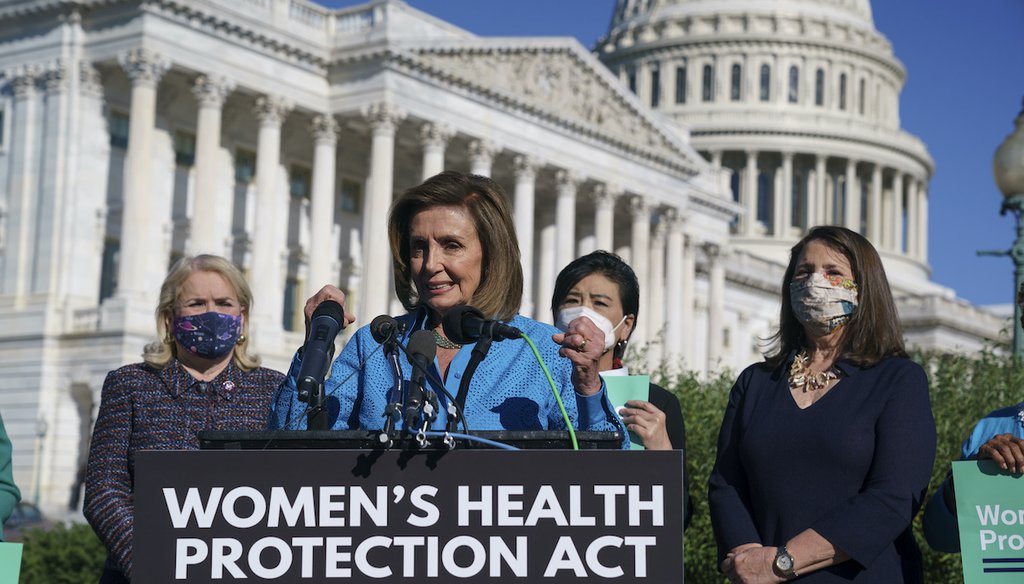Get PolitiFact in your inbox.

House Speaker Nancy Pelosi, D-Calif., and other Democratic lawmakers hold a news conference just before a House vote on a bill aimed at guaranteeing the right to an abortion on Sept. 24, 2021. (AP)
If Your Time is short
-
Democrats currently control the House, Senate and White House. People on social media suggested this fact alone was enough for the passage of abortion legislation.
-
However, Senate procedures prevent Democrats in the Senate from passing a bill that would protect abortion rights under federal law.
-
Passing a Senate bill that would protect abortion access would require 60 votes to end a filibuster from those opposed to abortion. This would require all Democrats to be united on this issue, plus the support of several Republican lawmakers.
Supporters of abortion rights are calling on Congress to pass a federal law that protects the right to abortion after Politico published a draft of a Supreme Court majority opinion that would overturn Roe v. Wade.
Overturning Roe, the 1973 landmark ruling that recognized the constitutional right to an abortion, would allow each state to set its own laws regarding abortion access.
Some social media users, seemingly incensed by President Joe Biden’s response to the leaked draft, took aim at Democrats.
"This morning Biden said ‘it will fall on voters to elect pro-choice officials this November,’" reads one May 4 Facebook post. "The Democrats control the Senate, House, & WH. They have the power to make legal abortion the law of the land once and for all. Instead, they treat women’s rights like a bargaining chip."
The post was flagged as part of Facebook’s efforts to combat false news and misinformation on its News Feed. (Read more about our partnership with Facebook.)
The post correctly quotes Biden’s May 3 statement that addressed the leaked Supreme Court draft opinion.
"If the Court does overturn Roe, it will fall on our nation’s elected officials at all levels of government to protect a woman’s right to choose," Biden said. "And it will fall on voters to elect pro-choice officials this November. At the federal level, we will need more pro-choice Senators and a pro-choice majority in the House to adopt legislation that codifies Roe, which I will work to pass and sign into law."
Democrats currently control the House, Senate and the White House. That power has significant limits, however, and Biden has a point when he says Democrats will need more members of Congress who support abortion rights to enact a federal law protecting those rights.
The House of Representatives is made up of 435 members. There are 221 Democrats and 209 Republicans. (There are five vacant seats due to deaths and resignations.)
In the 100-member Senate, Republicans hold 50 seats, Democrats hold 48 seats and the final two seats are held by independents who caucus and often vote in line with Democratic legislators.
Vice President Kamala Harris has the constitutional authority to vote when the Senate is evenly divided and can cast the tie-breaking vote for Democrats when needed.
However, under longstanding Senate procedure, Democrats need more than a simple majority to pass legislation that codifies Roe into law.
Why isn’t a simple majority enough to enact abortion access?
In September 2021, fearing the Supreme Court might overturn Roe, the House passed legislation that would codify abortion rights protections. That bill, called the Women’s Health Protection Act, would prohibit "governmental restrictions on the provision of, and access to, abortion services," according to the bill summary.
Support for the bill fell largely along party lines, with 218 Democrats voting in favor and one Democrat, Henry Cuellar of Texas, and 210 Republicans voting against.
Democrats have a narrow majority in the Senate. But the Senate is where things more commonly grind to a halt.
To pass most legislation, 60 Senate votes are required. Why?
Because of the filibuster, which essentially allows legislation to be blocked by a minority of 41 senators. The filibuster is a "loosely defined term for action designed to prolong debate and delay or prevent a vote on a bill, resolution, amendment, or other debatable question," according to the Senate’s website.
Before 1917, there was no way for senators to end debate and force a vote on a measure, meaning members of the minority party could block legislation indefinitely. In 1917, the Senate adopted a rule that allowed a two-thirds majority — or 67 senators — to end a filibuster via a procedure known as "cloture." The rules changed again in 1975 to only require 60 votes for cloture.
Since then, senators have created a few carve-outs to the filibuster. Executive branch and judicial confirmations require only 51 votes, and budget reconciliation rules now allow a simple majority to pass fiscal-related bills that follow a congressionally passed budget blueprint.
All this means that Democrats, whose total Senate votes fall short of 60 even when the caucus is united, do not have the power to pass legislation that would make abortion legal nationwide. And Democratic senators aren’t exactly united in their stance on abortion.
Sen. Joe Manchin of West Virginia and Sen. Bob Casey of Pennsylvania — both Democrats — describe themselves as "pro-life," and it is unclear whether they’d support legislation to codify Roe.
(In February, Casey voted to allow debate on the Women’s Health Protection Act, but also noted his work to prevent unintended pregnancies and abortions. Manchin voted not to allow debate, alongside Senate Republicans.)
Technically, Democrats could change the Senate’s rules to allow them to pass a bill that would protect abortion access with a simple 51-vote majority.
However, both Manchin and Sen. Kyrsten Sinema, D-Ariz., have said they do not support plans to change the rules and eliminate the filibuster, Axios reported after the draft opinion became public.
The Senate is scheduled to vote May 11 on advancing the Women’s Health Protection Act.
That effort is expected to fail, because Democrats don’t have enough votes.
RELATED: House passes bill to enshrine Roe v. Wade, but threats to ruling mount
RELATED: What would state laws look like in a post-Roe world?
Our Sources
Facebook post, May 4, 2022
NBC News, "House passes abortion rights bill amid challenges to Roe v. Wade," Sept. 24, 2021
NBC News, "Democrats push to codify Roe after leaked opinion. But they don’t have the votes," May 3, 2022
19th News, "The Supreme Court will overturn Roe v. Wade, according to a draft opinion. Here’s what we know," May 2, 2022
19th News, "Why didn’t Congress codify abortion rights?" Jan. 26, 2022
CNBC, "Democrats’ plan for a federal law to protect abortion rights faces huge hurdles in Congress," May 3, 2022
USA Today, "‘Whole range of rights could now be at risk’ if Roe v. Wade is overturned, Biden says; Obamas rip draft opinion: Live updates," May 3, 2022
The Guardian, "US shaken to its core by supreme court draft that would overturn Roe v Wade," May 3, 2022
Axios, "Democrats lack votes to end filibuster for abortion protections," March 3, 2022
Reuters, "In Supreme Court shadow, Biden urges voters to protect abortion rights," May 3, 2022
The White House, "Statement by President Joe Biden," May 3, 2022
Senate.gov, "Party Division," accessed May 6, 2022
History.house.gov, "Party Divisions of the House of Representatives, 1789 to Present," accessed May 6, 2022
U.S. House of Representatives Press Gallery, "Party Breakdown," accessed May 6, 2022
Senate.gov, "Constitution - Article 1, Section 3," accessed May 6, 2022
Senate.gov, "Votes to Break Ties in the Senate," accessed May 6, 2022
Five Thirty Eight, "Why The President’s Party Almost Always Has A Bad Midterm," Jan. 3, 2022
Politico, "Supreme Court has voted to overturn abortion rights, draft opinion shows," May 2, 2022
The Hill, "With minority bent on obstruction, US Senate still the place bills go to die," Aug. 22, 2021
Congress.gov, "H.R.3755 - Women's Health Protection Act of 2021," accessed May 6, 2022
United States House of Representatives Clerk, "Roll Call 295 | Bill Number: H. R. 3755," accessed May 6, 2022
NBC News, "House passes abortion rights bill amid challenges to Roe v. Wade," Sept. 24, 2021
CBS News, "Why is a simple majority usually not enough to pass a bill in the Senate?" July 18, 2017
The Philadelphia Inquirer, "Bob Casey is one of the last ‘pro-life’ Democrats. The Supreme Court decision is going to test his views," May 3, 2022
The Washington Post, "Senate Republicans, Manchin block bill to protect the right to abortion," Feb. 28, 2022
Casey.Senate.gov, "Casey Statement on the Women’s Health Protection Act," Feb. 17, 2022
United States Senate, "Senate Created," accessed May 9, 2022
NPR, "Senate Democrats plan a vote to change the filibuster. So what is it?" Jan. 17, 2022
PolitiFact, "The founders didn’t put a Senate filibuster into the Constitution," March 8, 2021
PolitiFact, "How unusual would it be to create a filibuster carve-out for voting rights?" Dec. 9, 2021
United States Senate, "About Filibusters and Cloture," accessed May 9, 2022
PolitiFact, "What you need to know about the budget reconciliation process," Feb. 8, 2021
NPR, "Senate Democrats plan a vote on abortion rights but it's unlikely to pass," May 10, 2022
CBS News, "Schumer says Senate will vote on advancing bill protecting abortion access next week," May 5, 2022
USA Today, "‘Sense of urgency’: Senate to vote Wednesday on bill that would make abortion legal nationally," May 5, 2022
The Guardian, "Senate Democrats aim to reveal which Republicans oppose abortion ahead of midterms – live," May 9, 2022
The Washington Post, "Senate Democrats tee up a doomed vote to write abortion protections into law," May 9, 2022


































